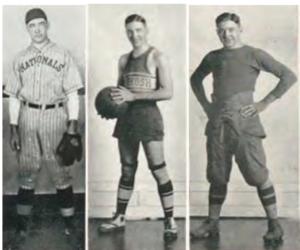Remembering the Titans: Robert Kolf
Robert Kolf was one of the most recognizable figures in the history of UWO Athletics
Courtesy of UWO Athletics — Robert Kolf took over as athletic director and head coach of every sport in 1931.
October 19, 2022
The inaugural UW Oshkosh Athletic Hall of Fame class in 1974 featured Robert “Bob” Kolf, often referred to as the greatest coach in the history of Titan athletics.
Kolf, an alumnus of the Oshkosh Normal School (now UWO), coached at the university for 44 years, racking up 29 conference championships in 10 different sports along the way.
“What Vince Lombardi is to the Green Bay Packers, Robert Kolf is to the Oshkosh Titans,” an issue of Alumni Spotlight published in 1988. “(He was) a dynamic force who shaped and molded the teams he coached and left a lasting imprint on the institution he served.”
Born in Minneapolis, in 1898, Kolf moved to Oshkosh at age 7 and quickly fell in love with the game of football.
Kolf said in a 1988 interview that as a young boy he used to sneak off from doing chores on Saturdays to play in football games around Oshkosh.
“I had two football suits, so I’d put one upstairs and one in the basement,” he said. “I’d throw my football suit out the window and crawl out after it. If I was upstairs, I’d throw the other suit out the window, go downstairs, get a glass of water and away I’d go.”
Kolf told Alumni Spotlight that he usually didn’t get back home until after dark.
“I used to play a game at Merrill School in the morning, go to Reed School in the early afternoon and then to South Park about 3 o’clock,” Kolf said. “We’d play several football games every Saturday.”
Kolf’s parents did not approve of their son playing football in high school, but eventually changed their mind after Kolf threatened to quit school altogether.
“They had a point, I only weighed 118 pounds,” Kolf said in 1988. “But I was so interested in football—I’d gone out to all the high school games and I’d read everything about football I could get my hands on. I just had to play.”
Just two years later, Kolf was the starting halfback for the Oshkosh High School football team and guard on the basketball team. After graduating from high school in 1915, Kolf worked at the First National Bank in Oshkosh, playing football for the city football team in his spare time.
Kolf enlisted in the Navy when the U.S. went to war in 1917 and attended the U.S. Naval Radio School at Harvard University.
“I was stationed in Norfolk, Virginia, and heard that the radio school at Harvard had organized a football team,” Kolf said to Alumni Spotlight. “I figured if I could get in, I might have a chance to play some football while I was going through the course.”
When Kolf arrived, he discovered that the football team was only open to former college students but got around that roadblock by saying he graduated from Ripon College. He easily made the team and was elected captain but resigned from the role after the school’s naval officers recruited men who’d played football for the top colleges around the country.
“There were 50 college football men, including nine All-Americans, and we were playing under a coach who’d been at Washington State before the war,” Kolf said in a 1988 interview. “Needless to say, I learned a great deal from that experience.”
After returning from Ireland, where he was stationed aboard the USS Caldwell later in the war, Kolf enrolled at the Oshkosh Normal School in 1919 and majored in history.
While at Oshkosh Kolf was a three-sport letter winner, playing football and basketball for all three years and baseball for two seasons with the Titans.
During the 1919 Oshkosh State Normal School football season captain-elect Kolf helped the Titans to a 5-1 record, securing second place in the Normal School Conference. Oshkosh’s only loss came against La Crosse, who would go on to be state champion, after a hard fought 18-7 game.
Kolf, who played half-back, was selected as team captain after Clifford “Whop” Taylor had a season ending injury, according to the 1920 Quiver yearbook.
“Bob proved to be one of the deadliest players in the Normal Conference,” the Quiver read. “As a passer and punter, he was certainly a whiz.”
The Oshkosh State Normal School basketball team, with Kolf as a starting guard, reached the conference championship in 1920 but fell to River Falls in both games of the best-of-three series.
The next season, Oshkosh claimed the conference championship by going 9-2 and taking both games against defending-champs River Falls. Oshkosh bullied their opponents with strong defense, literally engaging in a fight with Stevens Point on the court, while outscoring every team 287-127.
“Bob Kolf broke up more opponents’ plays than any other man,” the 1921 Quiver yearbook said. “He was a strong guard and with Bob Webster proved the best of conference guards.”
On the gridiron, Kolf led the Titans to their first football conference championship in 1920 as the team went 5-1-1 to claim the top spot in the southern division. In the championship game against River Falls, Kolf threw the winning touchdown to Webster with the contest finishing 6-0.
In his senior season, Kolf switched to quarterback and helped the Titans to a second-place finish with a 5-2 record, falling just one game behind La Crosse.
“With his knowledge of football, Bob was just the man for the quarterback position,” the Quiver yearbook said in 1922. “It was his cool head that pulled the team out of many tight places.”

Kolf and the Titans nearly defended their basketball championship in 1922 but were swept in the championship series by La Crosse 37-21 and 20-14, respectively. That season, Oshkosh went 16-5 while winning every regular-season conference game.
“Bob never failed to get the rebound from the opponent’s basket, but it was not this faculty alone that made Bob one of the best standing guards in the conference,” the Quiver printed. “He always played a cool game and seemed at his best in a close battle.”
After graduating from Oshkosh State Normal School in 1921, Kolf taught history for a year at Shawano High School and coached the basketball team to the state tournament in 1923, winning the consolation title.
Later that year, Kolf was offered a job as the assistant sports coach at Oshkosh State Normal School by his former college coach Howard Hancock.
Kolf said to Alumni Spotlight in 1988 that working alongside Hancock was a great experience.
“He was a grand man and cared about playing fair as much, or more, than he cared about the sport,” he said. “I tried to follow in his example through the years.”
Kolf took a leave of absence for part of the 1926-27 school year to get his bachelor’s degree from Ripon College, where he coached basketball and served as backfield coach of the football team.
In 1931, Kolf took over all of the Oshkosh’s sporting activities when Hancock left to take over the role of athletic director and head football coach at Illinois State Normal School (now Illinois State University). During the majority of his tenure at Oshkosh, Kolf was athletic director, coached and taught all physical education classes, as well as supervised all intramural sports.
“It was a big job,” Kolf said in 1988. “But to tell you the truth, I was so crazy about what I was doing, I didn’t know I was working that hard.”
When the U.S. entered WWII, Kolf enlisted in the military once again, serving as a lieutenant commander in the Navy aboard a fleet in the Pacific.
There were no varsity sports during the war years at Oshkosh (known as Oshkosh State Teacher’s College from 1927-51), but Kolf still found opportunities to coach while in the military, serving as the head of the recreation office on Manus Island for 12 months.
Kolf was responsible for coaching every collegiate sport at Wisconsin State College Oshkosh (renamed from Oshkosh State Teacher’s College in 1951) until 1955, when the head of the physical education department, Eric Kitzman, joined him as assistant football coach, and later taking over as head basketball and baseball coach.
“(Kolf’s) coaching philosophy was simple: make the other team earn a score; don’t give it to them and expect your team to do the same,” Kitzman said in 1988. “He insisted that his teams be in top physical condition, and he worked them hard.”
Ken Hansen, a football and basketball star for Oshkosh under Kolf in the late ’20s and early ’30s, said Kolf used to run his teams until they dropped.
“I’d see guys drop over and say, ‘I can’t go anymore!’ He’d just say, ‘turn in your suit’ and of course nobody did,” Hansen said in an interview with Alumni Spotlight. “We never knew what his middle initial ‘M’ stood for, but we had our own idea. Robert Mankiller Kolf, that’s what we used to say.”
Kolf stressed the use of fast break offense and zone defense as head basketball coach, a revolutionary tactic in an era when teams were lucky to score over 30 points.
Kolf coached the basketball team to four conference championships and led the football team to a title in 1935. As head tennis coach, Kolf led the program to 10 conference titles and the golf team to four championships and helped the track team win two trophies.
“It wasn’t so bad getting up at 6 in the morning as it was staying up until 1 or 2 a.m., that was the problem,” Kolf told the Advance-Titan in 1974. “I didn’t have a trainer or team manager and if a player was hurt, I had to take care of him, then go home, plan practices and study game plans.”
In 1964, Oshkosh Common Council President John E. Fitzgerald officially declared Sept. 19 as Bob Kolf Day to celebrate Kolf’s 45 years with Wisconsin State College Oshkosh. Surrounded by former players, Kolf was given a Distinguished Service Citation plaque by the Alumni Association at the football game against Eau Claire.
Years after his retirement, Kolf, who died in 1990, attended almost every athletic event at the university, later listening to games on the radio when he began to have health problems.
Kolf told the Advance-Titan in 1974, the athletic department had to face many obstacles during his time as athletic director.
“The teams lived from hand to mouth all the time. We cut corners whenever we could – we used the same jerseys from one sport to the next.”
Kolf said a lack of good facilities and the required 2.0 GPA hindered the athletic program during his years as athletic director.
Kolf had a hard time getting people to participate in athletics because most athletes came from the Industrial Arts School, which was dropped from the college in 1935.
“We lost about 100 people, the backbone of the teams when the industrial arts department was closed,” Kolf said in an interview with the Advance-Titan.
In order to recruit players to Oshkosh, Kolf wrote letters to area high school coaches and drove around the state in the summers.
Finally, in 1959, Kolf hired his first full time assistant in Russ Young, who later became a legendary Titan football coach and was inducted into the Athletic Hall of Fame in 1977.
In 1971, the Wisconsin State University Board of Regents decided to name the new physical education building and sports center at UWO after Kolf. The Kolf Sports Center replaced Albee Hall as the home for Titan basketball, gymnastics and wrestling, while also serving as the offices for the athletic and physical education departments.
The university rededicated the Kolf Sports Center in 2013 to celebrate Kolf’s accomplishments as one of the greatest Titans in the history of UWO.















